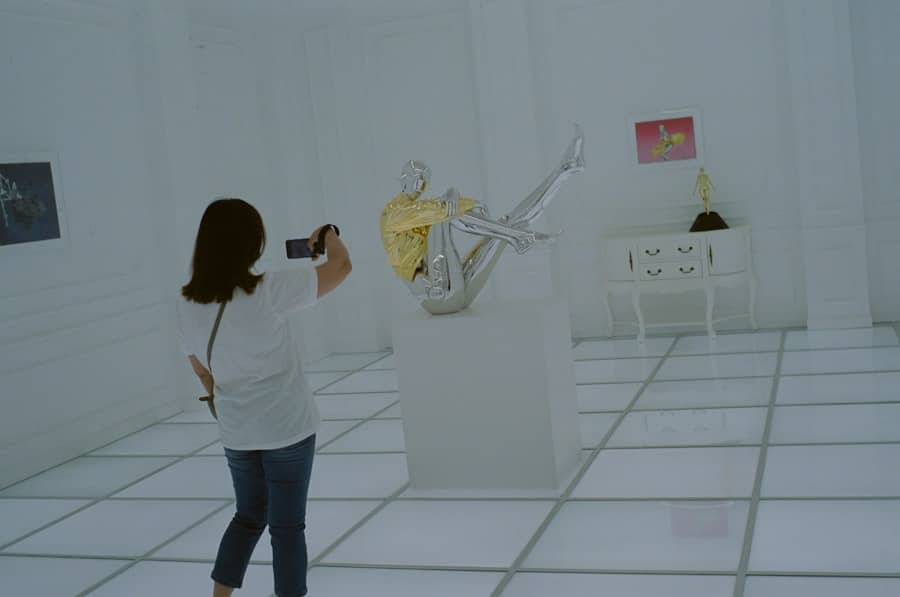Augmented Reality (AR) has emerged as a transformative technology that blends the digital and physical worlds, creating immersive experiences that captivate users. By overlaying digital information onto the real world, AR enhances our perception and interaction with our surroundings. This technology has found a unique application in outdoor puzzle and quest games, where players engage in problem-solving and exploration in real-world environments.
These games often require participants to navigate through parks, urban landscapes, or natural settings, solving puzzles and completing challenges that are intricately tied to their physical location. Outdoor puzzle and quest games have gained popularity as they encourage players to step outside, engage with their environment, and collaborate with others. The integration of AR into these games elevates the experience by providing dynamic content that responds to the player’s actions and location.
For instance, players might use their smartphones to reveal hidden clues or interact with virtual characters that guide them through the game. This fusion of technology and gameplay not only enhances the fun but also promotes physical activity and social interaction, making it a compelling option for both casual gamers and serious adventurers.
Key Takeaways
- AR technology enhances the outdoor puzzle and quest game experience by adding interactive elements and immersive storytelling.
- The use of AR in outdoor games provides benefits such as increased engagement, physical activity, and cognitive stimulation.
- AR enhances the immersive experience of outdoor puzzle and quest games by overlaying digital elements onto the real world, creating a seamless blend of virtual and physical environments.
- AR adds interactive elements to outdoor puzzle and quest games by allowing players to interact with virtual objects and characters in the real world.
- Successful integration of AR in outdoor puzzle and quest games can be seen in popular examples such as Pokemon Go and Ingress, which have revolutionized the gaming experience.
The Benefits of Using AR in Outdoor Puzzle and Quest Games
The incorporation of AR into outdoor puzzle and quest games offers numerous benefits that enhance gameplay and player engagement. One of the most significant advantages is the ability to create a more interactive and engaging experience. Traditional outdoor games often rely on static clues or physical props, which can limit creativity and player interaction.
In contrast, AR allows for dynamic content that can change based on player actions or environmental factors. For example, a player might scan a specific location with their device to unlock a virtual portal that leads to a new challenge or reveals additional layers of the story. Moreover, AR can significantly enhance the educational aspect of outdoor puzzle games.
By integrating historical facts, environmental information, or cultural insights into the gameplay, players can learn while they play. For instance, a quest game set in a historical district might use AR to display information about significant landmarks or events as players approach them. This not only enriches the gaming experience but also fosters a deeper connection to the environment, encouraging players to appreciate the history and culture surrounding them.
How AR Enhances the Immersive Experience of Outdoor Puzzle and Quest Games
Immersion is a critical component of any gaming experience, and AR takes this to new heights in outdoor puzzle and quest games. By seamlessly blending digital elements with the real world, AR creates a sense of presence that draws players into the narrative. When players encounter virtual characters or objects that appear to exist within their physical environment, it blurs the line between reality and fiction.
This heightened sense of immersion can lead to more profound emotional connections with the game, as players feel as though they are part of an unfolding story rather than mere observers. Additionally, AR can adapt to the player’s surroundings in real-time, further enhancing immersion.
This adaptability not only keeps gameplay fresh but also encourages players to explore their surroundings more thoroughly. The result is an engaging experience that feels personalized and responsive, making each player’s journey unique.
The Role of AR in Adding Interactive Elements to Outdoor Puzzle and Quest Games
Interactivity is a cornerstone of modern gaming, and AR significantly amplifies this aspect in outdoor puzzle and quest games. Players can engage with virtual elements in ways that were previously unimaginable. For instance, they might need to physically move around a location to find hidden clues or interact with virtual objects by tapping their screens or using gestures.
This level of interaction fosters a sense of agency, allowing players to feel more in control of their experience. Furthermore, AR can facilitate collaboration among players, enhancing social interaction during gameplay. Many outdoor puzzle games are designed for teams, where players must work together to solve challenges.
With AR, teams can share information in real-time, such as revealing clues or strategizing on how to tackle a particular puzzle. This collaborative aspect not only makes the game more enjoyable but also strengthens social bonds among participants. The shared experience of overcoming challenges together can lead to lasting memories and friendships.
Examples of Successful Integration of AR in Outdoor Puzzle and Quest Games
Several successful examples illustrate how AR has been effectively integrated into outdoor puzzle and quest games, showcasing its potential to enhance gameplay. One notable example is “Pokémon GO,” which revolutionized mobile gaming by encouraging players to explore their neighborhoods in search of virtual creatures. The game uses AR technology to place Pokémon in real-world locations, prompting players to visit parks, landmarks, and other public spaces.
This not only promotes physical activity but also fosters community engagement as players gather in groups to catch Pokémon together. Another example is “Zombies, Run!” which combines fitness with storytelling through an immersive audio experience. Players embark on missions where they must run through their neighborhoods while listening to a narrative that unfolds based on their location and pace.
The game incorporates AR elements by allowing players to collect supplies and interact with virtual characters during their runs. This innovative approach not only motivates players to exercise but also creates an engaging narrative that keeps them invested in their fitness journey.
Challenges and Limitations of Using AR in Outdoor Puzzle and Quest Games
Accessibility and Technological Literacy
One significant limitation is the reliance on technology, particularly smartphones or tablets, which can be a barrier for some players. Not everyone has access to high-quality devices capable of running advanced AR applications smoothly. Moreover, varying levels of technological literacy among players can lead to disparities in gameplay experiences; some may struggle with the technology while others excel.
Designing Engaging AR Experiences
Another challenge lies in the design of AR content itself. Creating engaging and meaningful AR experiences requires careful planning and execution. Developers must ensure that virtual elements are seamlessly integrated into the real world without overwhelming or distracting players from the core gameplay.
Environmental Factors and Technical Issues
Environmental factors such as lighting conditions or GPS accuracy can impact the effectiveness of AR features. For instance, poor lighting may hinder the visibility of virtual objects, while GPS inaccuracies could lead to frustration if players are unable to locate clues or objectives.
Future Trends and Innovations in AR for Outdoor Puzzle and Quest Games
As technology continues to evolve, so too will the possibilities for AR in outdoor puzzle and quest games. One promising trend is the advancement of wearable technology, such as smart glasses or augmented reality headsets. These devices could provide a more immersive experience by allowing players to interact with virtual elements without needing to look down at their smartphones constantly.
Imagine exploring a city while receiving real-time information about your surroundings through an AR headset—this could revolutionize how players engage with outdoor quests. Additionally, advancements in artificial intelligence (AI) could enhance the interactivity of AR experiences. AI algorithms could analyze player behavior and adapt challenges accordingly, creating personalized gameplay experiences that cater to individual preferences and skill levels.
This level of customization could make outdoor puzzle games more appealing to a broader audience by accommodating varying degrees of expertise.
The Potential of AR in Revolutionizing Outdoor Puzzle and Quest Games
The potential for augmented reality to revolutionize outdoor puzzle and quest games is immense. By enhancing interactivity, immersion, and educational value, AR transforms traditional gameplay into dynamic experiences that engage players on multiple levels. As technology continues to advance, we can expect even more innovative applications of AR in this space, paving the way for new forms of entertainment that blend physical exploration with digital storytelling.
The future holds exciting possibilities for outdoor puzzle and quest games powered by augmented reality. As developers continue to push the boundaries of what is possible with this technology, we may see entirely new genres emerge that redefine how we play outdoors. Whether through enhanced social interactions or personalized gameplay experiences, AR has the potential to create lasting memories for players while encouraging them to explore the world around them in ways they never thought possible.




